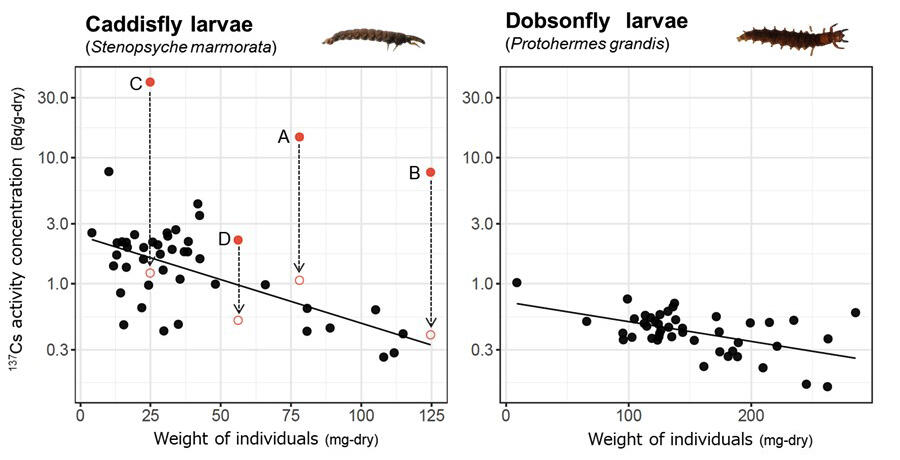A research group led by Senior Researcher Yumiko Ishii at the Fukushima Branch of the National Institute for Environmental Studies (NIES), researcher Hikaru Miura of the Meteorology and Fluid Science Division, Sustainable System Research Laboratory, Central Research Institute of Electric Power Industry, in collaboration with Fukushima Prefectural Centre for Environmental Creation, Japan Atomic Energy Agency, National Agriculture and Food Research Organization, Fukushima University and the University of Tokyo, has measured the concentration of radiocesium in individual aquatic insects and announced they found that individuals with high concentrations of radiocesium contained insoluble radiocesium particles (CsMPs, also known as cesium balls in Japan) in their digestive tracts. The concentration of radiocesium decreased with the removal of the cesium balls. Their study revealed the uptake of radiocesium particles into organisms and food webs for the first time. The results are expected to lead to improved accuracy in predicting future radiocesium concentrations in nature. The research group's results were published in PLOS ONE.

Provided by NIES
Freshwater fish with high levels of radiocesium can still be found in some areas of Fukushima Prefecture, and distribution restrictions remain in place. It is known that the majority of radiocesium in freshwater fish is taken up through food. Therefore, in order to demystify the mechanism of radiocesium transfer from the environment to freshwater fish, it is necessary to determine the concentration of radiocesium in aquatic insects, which are their main food source.
To date, the research group has measured radiocesium concentrations in individual aquatic insects collected from the Ota River in Fukushima Prefecture and found large variations in these concentrations. Their measurements showed that aquatic insects may be ingesting insoluble cesium balls. On the other hand, it was unclear how these cesium balls were ingested by the organisms. Cesium balls are insoluble particles containing glassy radioactive cesium ranging from 0.1 to 10 μm in diameter and are known to be expelled within a few days after organisms ingest them as food.
In their study, the research group measured the concentration of radiocesium individually for two species of aquatic insects, Stenopsyche marmorata (a species of caddisfly) and megaloptera (snake dobsonfly), collected from the Ota River in Fukushima prefecture in 2018. These two species are relatively abundant aquatic insects that serve as food for freshwater fish and have a population size that allows the concentration of cesium to be measured.
The group found that concentrations of radiocesium varied among the caddisflies, with four of the 46 individuals showing noticeably high values. In individuals with high concentrations, their concentrations were about one order of magnitude higher than those of other individuals. There was no such variation in the snake dobsonflies.
The research group examined the presence of cesium balls by autoradiography and confirmed cesium balls in four caddisflies that had high concentrations of radiocesium. The concentration of radiocesium decreased significantly when they removed the cesium balls. They found that concentrations were dependent on the uptake of cesium balls.
Previous studies have shown that more than 90% of the radiocesium in caddisflies is distributed in the digestive tract, with less than 10% of the radiocesium in other tissues. Less than 10% of this amount is believed to be derived from water-soluble radiocesium. Larger individuals of both species of insect tended to have lower radiocesium concentrations, possibly due to the smaller weight of digestive tract contents as a percentage of the total body weight of larger individuals.
Surveys of the surrounding area revealed that cesium balls were found not only in caddisflies, but also in the algae they eat and in rivers. Analysis of these particles using electron microscopes and other techniques confirmed that they were similar in size and elemental composition to particles confirmed to have been scattered in the accident at the TEPCO Fukushima Daiichi Nuclear Power Station.
No cesium balls were identified in 45 caddisflies, which appeared to indicate a difference in the feeding habits of the two aquatic insect species. Caddisflies feed on algae and organic matter, while snake dobsonflies feed on other small aquatic insects and other organisms. Since the food and cesium balls of the caddisfly were of similar size, it was thought that they could easily be ingested with food.
There is little chance that cesium balls remain in the body of an organism. On the other hand, if the target biological sample is ingested during measurement, the concentration of radiocesium may not be measured accurately. The results of this study also indicate that it is important to consider the presence of cesium balls in understanding the dynamics of radiocesium transfer into the food web.
"Cesium balls taken up by aquatic insects are naturally thought to be ingested by the digestive tracts of the fish that eat them," explains Senior Researcher Ishii. "We intend to study the presence of cesium balls in the digestive tract of fish and their uptake into body tissues."
This article has been translated by JST with permission from The Science News Ltd.(https://sci-news.co.jp/). Unauthorized reproduction of the article and photographs is prohibited.




